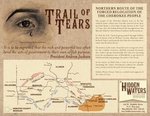

Historian Mark Spangler addressed the community at the June 22 Webster County Historical Society Meeting at the Callaway Cabin regarding a local segment of the Trail of Tears. Hidden Waters Nature Park has a unique history, with more being uncovered as time goes on. After the famous 1880 tornado, several springs were uncovered at what is now known as Hidden Waters Nature Park. This park was also verified as a segment of the Trail of Tears in the spring of 2018.
“Three years ago we pin-pointed the fact that the trail goes through the park, that’s what prompted the signage seen in the park… but we’re still working to get National Parks Service signage in there at some point,” said Spangler. “The ball is in their court but we’ve been trying to get National Parks Service recognition.”
“We didn’t know the significance of the lands history until we were told in 2018,” explained Friends of Hidden Waters park board President Chris Davis. “It’s just a significant point in history that most people don’t know about. They don’t know any of the history of it and I didn’t know a lot about it myself… we started digging further when we learned of the land’s significance.”
B.B. Cannon headed a military escort which led the first Cherokee detachment through what is now Marshfield on December 14, 1837. Cannon spent the previous night west of the Burnett farm on a branch of Bowen Creek with recorded interaction with early settler James Edington. Passing through the future site of Marshfield, he recorded no further interaction with locals, noting only that camp was made that night on James Fork – a site today located south of Northview, Mo.
Another documented group of Cherokees was the Taylor party, recorded by Reverend Butrick and Dr. Morrow. This group passed through modern Webster County in March of 1839 encamped at the Burnett Farm on Osage Fork, between Rader and Niangua, Mo. It’s estimated that their next camp fell within the modern western boundary of Marshfield, or further west where the road came alongside the Pomme de Terre River.
“One thing we learned was that they funded their own caravan and dressed in European clothing… there were no loincloths or feathers,” she said. “They actually had rifles and were encouraged to hunt as they crossed to their destination in Tahlequah, Oklahoma. A lot of them owned big plantations and were very wealthy… there are incredible details that I had no idea about.”
The Taylor group was the last Cherokee detachment to utilize the Northern Route and unwittingly became competitors with the Hildebrand detachment who passed well to the south of Hidden Waters Park, thought to be along James Fork in Southern Webster County. Hildebrand did not rejoin the Northern Route roadway until somewhere near what is now Strafford.
“We know about the Cannon group that passed through Hidden Waters in 1837 but a total of 10 more, including the Taylor detachment, passed through. We know this because of journals that were kept.. but we have no written accounts of the actions or experiences of 9 other groups,” she said. “Anyone with what they think could be a useful journal is always urged to share its contents with us. The men that led those detachments were supposed to keep journals and that’s the reason we know so much about it… without the journals we wouldn’t know anything”
“There is still another branch of the Trail of Tears that was followed by one of the detachments that has not been identified,” Spangler added. We need to be working on the research aspect of that… the segment of the trail that passes through the park is pin-pointed but the portion that traveled more to the south, down along James Fork… that part of the Trail of Tears we have not identified as far as exactly where it is. There’s still researching to be done here in Webster County.”
According to Davis, the park is working to complete a new welcome center which will house several presentations regarding park history, including the significance of the Trail of Tears. The Cherokee Nation tribe has been invited to attend the opening event in 2022.
“The Trail of Tears has definitely become an educational stop for people to learn about the people who were forcibly removed from their land. We’ve confirmed the information displayed at the park with the Cherokee Nation and representatives of the Nation have visited before along with the Department of Humanities,” she added. “It’s an important factor for history, we have a beautiful nature park, happen to be located on old Route 66 and we have the opportunity to pay tribute to those people that were removed.”
Comments
No comments on this item Please log in to comment by clicking here